Please enjoy my Summary of Learning
for Instructional Technologies Application:
(best viewed full screen!)
SAVvy Art Teacher
Sunday, April 30, 2017
Monday, April 24, 2017
Major Project - What I Learned through Photoshop
Major Project - What I Learned...
OK, so after many, many hours watching YouTube videos, Lynda.com tutorials, Adobe Help resources, and several pow wows with a graphic artist, am I a Photoshop Master? Hahaha... not quite. I am seriously humbled by this process. I had anticipated doing much more with the project, but it's not from lack of time spent... it's from the programs being much more complicated than I thought they'd be! I'd wanted to experiment with Illustrator and InDesign as well, (and I tried with Illustrator but got so confused I went back to the relative safety of Photoshop!) But I learned quite a bit with Photoshop and I'm inspired to continue learning. All I'd used it for previously was very basic retouching and album design - just arranging photos, not altering them much. But now - as you'll see from my tutorial (which I had to reduce from 1 hour, 4 minutes to 15 minutes! Not an easy feat! So, technically I did learn a second program - Camtasia - a video screen recorder/editing software that was really novice-user friendly but it took some Help tutorials to get that one down too!) Camtasia is a paid service, but I did the free trial, which unfortunately leaves an annoying watermark across the screen. And after I struggled for over an hour to get it to upload to Youtube, I realized it was because of the length. So I spent several more hours editing it down! It's amazing how much time it takes to shorten the time of something!!
It's a little disjointed and I'm not totally satisfied with the result... but it was a respectable first try at a tutorial. Besides...
All in all, I learned how to make several things with Photoshop: How to superimpose one image on another, and create shadows...
I created 2-sided invitations, learning how to manipulate text, import multiple images, and incorporate the fundamentals of design...
I made a menu - the hardest part of which was making individual cupcake photos when no such pictures exist, so I had to make composites to fill in sections that were blocked from view....
After failing miserably to create a logo in Illustrator, I "made magic happen" and turned the vision in my head into a real logo...
So, that's five digital artifacts that I couldn't have made before this project. I'm pretty proud of myself. I may not be a "Master" of Photoshop, but I've certainly gained enough knowledge of methods of graphic design and using the software that I feel like I'm well on my way to becoming a competent teacher!
Being that this party was just Saturday, and Sunday was spent cleaning up the whirlwind... I didn't have time to incorporate any other of these photos into a completed new advertisement for GoodWitch Party Magic... but it's my blog, so I'm gonna share some photos with you anyway! Here's my awesome "Chapter 2 - Story Book Party"...
 | ||
| I made Thing 1 and 2 costumes for the Birthday Girl and her favorite doll. Although she had a Thing 2 headband, she would only wear my cat ears. |
 |
| Storybook Cupcake Display |
 |
| Very Hungry Caterpillar fruit tray |
 |
| Madeline and Give a Mouse a Cookie |
 |
| She wanted more frosting... |
 |
| Hand-painted Very Hungry Caterpillar beanbag toss game for the toddlers. |
I did throw a quick illustrated menu together, using the menu I designed (via Photoshop) for the party, and I remembered to take individual photos of cupcakes this year, so progress!
Whew. That weekend flew... 2 straight days of baking, decorating, sewing, planning... cleaning... then homework and finals stuff. Thank goodness this semester is almost over! I'm exhausted!
Next time you need a little party magic...especially over the summer... just let me know :)
Wednesday, April 19, 2017
Major Project... Making Progress with Photoshop - Logo and Menu!
Making progress in Photoshop! Finally!
So, after becoming so frustrated with Illustrator that I had to stop myself from throwing my laptop into the lake, I decided that I would attempt to make the logo I am picturing in Photoshop for my imaginary cupcake/party planning business. TA-DA!!!
Isn't that adorable? It only took me about an hour... maybe a little more. I know that logos are better suited as vectors - which, I learned through the magic of the internet, are basically files that could be enlarged infinitely (think, billboards and bus wraps). Since I have no bus to wrap or billboard to design, and for the safety of my laptop, because I have become more comfortable in Photoshop over the past few weeks, I figured why not try it. I watched a few YouTube tutorials... like this one:
And I was off and running. Maybe since I at least have a little experience with Photoshop, the tools are more intuitive for me than the mysterious interface of Illustrator. So it wasn't that bad! I'm actually pretty proud of my Good Witch Cupcakery and General Party Magic logo! It's good to feel like I finally accomplished something worthwhile with this Major Project I so crazily proposed!!
Next, I figured I'd make a cupcake menu for a Wizard of Oz party. I wish I had thought to take individual pictures of the seven different types of cupcakes I'd made last year... but at the time it never crossed my mind - at 4 in the morning - as I was making 2 dozen tiny fondant bows and using icing to glue Hershey's Kisses to mini York Patties to make witch hats.

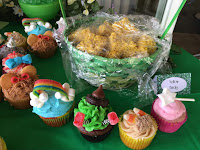
So I took as many of the big display photos that I could find and attempted to locate unobstructed views of each variety. If I found one then I just cut the pixels around the cupcake that I wanted, placed it on a transparent background and dragged it as a new layer onto my menu. The hard part were the few cupcakes that I didn't have whole-form images of. So I cut out what I could, then copied and mirror-image flipped chunks of the bases or frosting and Frankensteined together 2 complete cupcakes. Bet you can't tell which ones...
One of the most important things I learned was how to manage my layers. With 7 different individual cupcakes, 14 text boxes and 7 colored rectangles plus the division lines, etc. I kept getting confused. There were like 40 layers! BUT, from my Lynda.com tutorial that my graphic artist friend was nice enough to give me access to (but I cannot pass the link on to you) I learned that you can group similar layers in to folders, which you can collapse and make your project way more manageable.
 |
| See, I put all the cupcake names into one folder... |
 |
| Then I can collapse the folder with the little arrow by it and get them out of my view! |
Tuesday, April 18, 2017
Major Project... Feeling Squirrelly - Getting to know Photoshop - ONLY Photoshop
Taming the Inner Squirrels... and Playground Ruffians...
and other Photoshop Adventures
OK. Time for some alteration on the "Master Plan" here. Because Adobe products are so immersive and capable of so much, I will devote the entirety of this project to Photoshop. Since I will be taking an Independent Study this summer for learning more kid-friendly computer design programs to incorporate into my Art Ed curriculum, I'd rather know one program really well for now, rather than barely grasping 3 different ones. It's been too overwhelming, because every time I'm struggling with the Photoshop part, there's a naggy little voice in the back of my head going "Just wait until you get in to Illustrator, sucker! You don't even know what a vector really is! Mwahaha..." Or something like that. My inner voice can be a jerk sometimes.
 But instead of listening to the evil squirrel, I think I'll let my more zen inner voice come to the surface. The one who says it is better to do one thing really well than to knock myself out trying to do too many things adequately. In a week where I am trying to work at my job, write a massive term paper, navigate final group projects, take care of all the other little assignments tossed in there, throw my daughter a birthday party with 40 people, take her to the doctor's because not only is she having minor surgery after her birthday - but some frisky little toddler bit her face on the jungle gym because she wouldn't kiss him. No joke. Bit. Her. Face. I know this is not related at all to the task at hand, but it's my blog and I can talk about whatever I want. BIT. HER. FACE!!! In her haste to get away from the little monster, she tripped and scraped her knee and scratched her nose pretty bad. Now she has scratches, bite marks, bruises, and an unrelated bug bite. All in time for lots and lots of birthday photos. Fantastic. But hey... and here's where we get back on track... I'll know how to Photoshop all that crap right off of her. It's good to be techy!
But instead of listening to the evil squirrel, I think I'll let my more zen inner voice come to the surface. The one who says it is better to do one thing really well than to knock myself out trying to do too many things adequately. In a week where I am trying to work at my job, write a massive term paper, navigate final group projects, take care of all the other little assignments tossed in there, throw my daughter a birthday party with 40 people, take her to the doctor's because not only is she having minor surgery after her birthday - but some frisky little toddler bit her face on the jungle gym because she wouldn't kiss him. No joke. Bit. Her. Face. I know this is not related at all to the task at hand, but it's my blog and I can talk about whatever I want. BIT. HER. FACE!!! In her haste to get away from the little monster, she tripped and scraped her knee and scratched her nose pretty bad. Now she has scratches, bite marks, bruises, and an unrelated bug bite. All in time for lots and lots of birthday photos. Fantastic. But hey... and here's where we get back on track... I'll know how to Photoshop all that crap right off of her. It's good to be techy! So today I decided to research exactly what "Layer Masks" are. For that giant term paper I mentioned (my reflections on my first semester of field experience), I'd had to alter a few photos I'd taken of handouts and art projects. They were all slightly skewed pictures because of the distortion that happens when you don't photograph head-on. I messed around with the Transform tools until I found "Warp" to be very helpful and now you'd never know the images in my paper aren't scans of handouts in my possession. As I was testing methods out for fixing the perspective, I keep coming across items about Layers... Adjustment Layers, Fill Layers, Layer Style, Layer Masks... I could figure out what most of them do, but I wasn't sure about the Masks. So I found a helpful little tutorial: Adobe Help for Layer Masks. Apparently, I'm in a bit of a squirrel mood - perhaps the threat of "baby-rabies" my daughter could have caught has me fearing rodents... I don't know. But I decided to experiment a little with clipping masks.

+
=
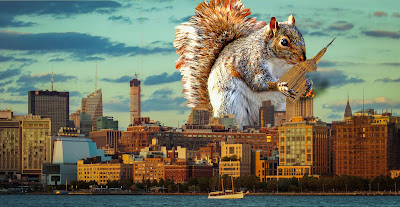
Here is my quick product. Not spectacular, and a lot could be cleaned up... the Squirrelzilla destruction intensified... but I just wanted to experiment. This has nothing to do with cupcakes or parties. But I'm tired of looking at cupcakes and parties - between this project and planning a 2nd birthday - I'm partied out already. So I've stooped to squirrels. Oh well, it did the job.
I have yet to "film" my screen activity because my methods are still so sloppy, and no one wants to watch me stumble through a demonstration... so I'm building up a little more expertise. Thus these little experiments. I've decided I like layer masks because instead of cutting the material from one layer that you don't anticipate not needing, you are just blocking them from view and you could make them visible again quite easily if you misjudged what you wanted hidden from view. This would have come in handy doing the dozens of "head-swaps" I did in group photos for the wedding photographer I worked for. There's always that blinky uncle in the back row who needs to be photographically decapitated and reassembled with functional eyes. The masking tool could make for a really seamless swap. Very cool. Maybe I wasn't "nuts" doing this project after all.
Sorry, I couldn't help myself. Just feeling squirrelly I guess.
Sunday, April 16, 2017
Major Project Update.... Ugh.
Major Project Update.... Ugh.
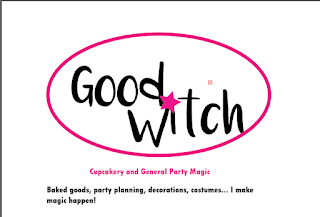
I know exactly what I want my final logo to look like. I could even draw it out for you! I have all the elements I need, it's just that I can't get the program to do what I want. I spent several hours trying it myself. I thought of a name, a slogan... I found and downloaded a font - a first for me! But that's where the successes ended.
I've perused YouTube, referred to Adobe's Help resources there's even an Illutrator Logo design help, even had a short pow- wow with my graphic designer resource person. We literally sat in front of my laptop for an hour messing with it. All I want is for the pink text to be incorporated into the bottom arch of the oval - like interrupt the line but continue the shape visually. I kid you not, we couldn't do it! He kept saying how un-intuitive the Illustrator program is.
Apparently he uses something called Corel and he said this would take 3 minutes in that program. He even showed me where the buttons would be to do it! Seriously - we could get the text to link to the shape. We could get it to "flip". We got it to rotate (the wrong way). But it was impossible to get the text in to the right position, facing the right way. Very frustrating. I don't know if I'll be able to really become familiar with both of these programs by the end of this project. I will give it a go. I've got no choice! But I just wanted to update you all... this is not going well!!! I'm going to try that Lynda program he told me about - maybe that will help! At this point, it couldn't hurt. Because there's more I want to do - manipulate the "Good Witch" text, make the "W" look like a wand with the star serving as the dot for the "i" - but I need the oval the way I want it first! I'm half tempted to just try to do the logo in Photoshop and devote the project to just Photoshop. There's certainly enough to learn that it would be a thorough learning experience.
 |
| See, this stuff I can do!!! |
With this Photoshop, Illustrator thing I already have a finished product in my head and I can't figure out how to use this blasted "medium" (my computer) to make it a reality. A painting evolves. I have a general concept but just go with the creative flow as I work. With this graphic design stuff I am trying to do such specific actions to achieve an image I already have planned. A professional can do it (with the right software, apparently), that's how they work - taking client's vision and making it real. An amateur like me is just getting overwhelmed. It's hard because I don't know how to word exactly what it is I'm trying to do in order to find the resources to instruct me.
I'm trying to remind myself this is my first "blended learning" class, that I've never tried to teach myself something techy completely unsupervised. As much as I've enjoyed the class-and-blog combo for this class... as far as Adobe goes, perhaps a self-directed learning exploration of this medium was not the way to go. This might be more of a thing I need an instructor over my shoulder, pointing things out and explaining... answering my specific questions. Hopefully I figure this out soon, because I'm running out of time.
Productivity - Can Tech Really Help an ART Teacher?!
I don't like most technology.
But I just might learn to.
So besides my Major Project posts - (which I seriously need to catch up on! Life has gotten in the way of school in ways I hadn't anticipated. But it will get done.) Besides those, this is the last "assigned" blog response for my Tech class. As resistant as I was to this entire class in theory... i.e. when I saw I was required to take an "Instructional Technologies"course as part of my Masters in Curriculum for Visual Art Education (K-12) I'm not gonna lie, I balked a little. "What kind of technology could I possibly need to incorporate into teaching seventh graders art?" In my seventh grade days there wasn't even a computer in the classroom. Paper mache was about as "high-tech" as it got.
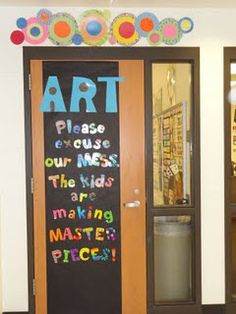
To be honest, I still think of art as a very low-tech endeavor. Art is paper and clay and paint and ink and canvas and plaster... you get the idea. It's messy. I know there is Graphic Art and Design... and I've had experience with them (I was reluctant about that too, as you can read about in my Cool Tool blog examining Canva). I still am way more comfortable with a paintbrush than anything Adobe related - I spent 2 hours last night unsuccessfully messing around with Illustrator. Very frustrating program to learn on your own. But that's a different post.
The thought of instructing children in graphic design scares the finger paint out of me - half of them could probably teach me something! But after having delved deeper into that field with the specific goal of learning how to teach it, I realized just how much I have to learn. I've accepted that technology isn't going away and that I will be expected to employ it effectively with students. With how complicated Adobe stuff can be (turns out 50 hours is barely enough time to learn Photoshop... let alone the other programs!), I'm not sure it's the most effective way to introduce students to photo editing and graphic design. That's why the Major Project actually inspired a self-directed Independent Study class that my Art Ed professor and I will design for myself to learn more about graphic design programs that might be more user friendly for beginners. Turns out I like learning about this stuff. I'm not very good at it, but some intensive study should help me feel not so inept.
The thing is, it's amazing how interconnected all of my classes have been thus far, how much the things I learn in Ed. Psych, Literacy, Instructional Tech, and especially the field experiences in an actual middle and high school (nothing like trial by fire!) all overlap. I learned how seamlessly technology can be incorporated into even the classic fine-art setting that I find so sacredly tech-proof. Even if I don't find ways to incorporate the graphic design element (maybe where I'm teaching won't have access to that stuff) I could still use programs to help streamline my productivity. Organizers, databases of lesson plans, etc.

To be honest, I still think of art as a very low-tech endeavor. Art is paper and clay and paint and ink and canvas and plaster... you get the idea. It's messy. I know there is Graphic Art and Design... and I've had experience with them (I was reluctant about that too, as you can read about in my Cool Tool blog examining Canva). I still am way more comfortable with a paintbrush than anything Adobe related - I spent 2 hours last night unsuccessfully messing around with Illustrator. Very frustrating program to learn on your own. But that's a different post.
The thought of instructing children in graphic design scares the finger paint out of me - half of them could probably teach me something! But after having delved deeper into that field with the specific goal of learning how to teach it, I realized just how much I have to learn. I've accepted that technology isn't going away and that I will be expected to employ it effectively with students. With how complicated Adobe stuff can be (turns out 50 hours is barely enough time to learn Photoshop... let alone the other programs!), I'm not sure it's the most effective way to introduce students to photo editing and graphic design. That's why the Major Project actually inspired a self-directed Independent Study class that my Art Ed professor and I will design for myself to learn more about graphic design programs that might be more user friendly for beginners. Turns out I like learning about this stuff. I'm not very good at it, but some intensive study should help me feel not so inept.
The thing is, it's amazing how interconnected all of my classes have been thus far, how much the things I learn in Ed. Psych, Literacy, Instructional Tech, and especially the field experiences in an actual middle and high school (nothing like trial by fire!) all overlap. I learned how seamlessly technology can be incorporated into even the classic fine-art setting that I find so sacredly tech-proof. Even if I don't find ways to incorporate the graphic design element (maybe where I'm teaching won't have access to that stuff) I could still use programs to help streamline my productivity. Organizers, databases of lesson plans, etc.
- This list of 5 Tools for Increasing Teacher Productivity was intriguing. I am queen lists... I am also duchess of Post-It notes, jotting cryptic reminders on my hand, and hasty scribbles on receipts and napkins. That i inevitably lose. After doing my field experience with an art teacher I saw first hand the importance of planning and organization. The school's online platform kept her organized pretty well. Lesson plans, grades, places to submit written assignments, email with students and families, etc. However, since I have no idea where I'll end up teaching and if my school does not have such a handy program, I could see using these sort of programs on the list after some experimentation.
- Teachers Pay Teachers is apparently a God-send for teachers of all kind - or so the Akron teachers I worked with told me. It's pretty much a place to download free or paid lesson plans, worksheets, and the like. So that seems like something I could use. My cooperating teacher was a big fan and showed me how much good stuff was on it. According to their website, this is what they do:
Who We Are and What We DoTeachers Pay Teachers (or TpT, as we call it) is a community of millions of educators who come together to share their work, their insights, and their inspiration with one another. We are the first and largest open marketplace where teachers share, sell, and buy original educational resources. That means immediate access to a world of expertise and more time to focus on students and teaching.
- During that field experience I saw so many interesting ways that the teachers and students used technology. The Smart Boards allow for making a plethora of content easy to switch between and interact with. I saw interactive quizzes - like with Kahoot! The students collaborated seamlessly with Google programs - Slides...GoogleDocs... The watched YouTube videos applicable to the content they were learning. Tech was everywhere... no avoiding it. And I actually come to find myself embracing it.
- My daughter's daycare/preschool uses Remind to keep in touch with parents. They send me friendly reminders, requests for items for different projects (last week they needed toilet paper tubes... this week it's "green things"). I get school wide announcements - which is great since my almost-two year old can't necessarily deliver messages to me and she only goes twice a week so I need to stay in the loop. Plus I get those little daily recaps that I love so much. Programs like that could be invaluable - especially considering I could be teaching over a hundred students a day over multiple periods. To be able to send out requests for newspapers for good old-fashioned paper mache or let parents know about an upcoming art show... now that would be cool. Kids take in a lot of information every day, who knows how many messages from school don't get passed on at home!?
As you can see, the opportunities for organization, collaboration, and communication are pretty unlimited. This semester - in all of my classes, really (but mostly this one). With the demands on teachers going higher and higher, organization will be key to productivity. I always have good intentions... I have no idea how many daily planners I have that are well-filled out until about...oh.... March. But computers and apps can remind me, nag me even, to stay on task. Be productive. Be organized. There are programs to keep me connected with students, with parents, with other teachers.
Who knew computers could be so great? (Well, a lot of people do, but I wasn't one of them!)
In fact, I like them so much that I just might keep this blog up after this class is over. Huh. Weird.
Friday, April 14, 2017
Blended Learning - Finding a Balance
A Blended Approach to Learning...
Not as Hard To Swallow as I'd Feared
This being my very first semester of school after a 7 year hiatus from college, a lot has changed. Grad school is a whole different ball game in itself... the mindset is just different. Plus, there's the fact that "being a student" is not my only job this time. Now I'm a bank teller and mommy. It's a balancing act to be sure. A real exercise in tightrope walking - without a net. Hey, speaking of "net"... internet... technology... what a segue, right!?
The thing I've noticed has changed the most in my seven year absence from higher learning is the integration of technology.
In undergrad, I had a laptop... but I don't remember ever taking it to class. Papers were submitted in hard copy form - and I had a terrible relationship with every printer on that campus, I swear! Quizzes and tests were on paper too, and you were lucky to get open note/book. The professor's PowerPoints were not available to view at my leisure - you'd better take good notes in class! I remember making horribly hurried sketches of Renaissance paintings next to their titles and descriptions in my notebook just to try to remember this Madonna and Child is different from that Madonna and Child (and that one... and that one...)
The thing I've noticed has changed the most in my seven year absence from higher learning is the integration of technology.
In undergrad, I had a laptop... but I don't remember ever taking it to class. Papers were submitted in hard copy form - and I had a terrible relationship with every printer on that campus, I swear! Quizzes and tests were on paper too, and you were lucky to get open note/book. The professor's PowerPoints were not available to view at my leisure - you'd better take good notes in class! I remember making horribly hurried sketches of Renaissance paintings next to their titles and descriptions in my notebook just to try to remember this Madonna and Child is different from that Madonna and Child (and that one... and that one...)
.
And do you even know how many renditions of the Assumption there are!? After class I'd have to find images of each piece of art online and print out good-sized thumbnails to glue onto note cards with the descriptions on the back (while everything was fresh in my mind) so I'd have them to study for tests. Thank goodness eventually artists branched out from religious imagery - if only for variety's sake!
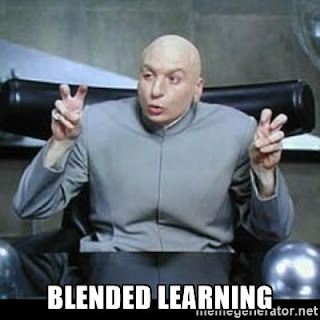 Had those art history classes been part of a Blended Learning curriculum, my chicken-scratch sketches would have been unnecessary. I could look at the professor's PowerPoint lecture, viewing the paintings at my own pace. The Online Learning Consortium defines Blended learning courses are classes where usually 30%-70% of the instruction is delivered online. The rest of the class interaction takes place online. The degree to which online coursework replaces traditional varies greatly by class, discipline, and learning objectives.
Had those art history classes been part of a Blended Learning curriculum, my chicken-scratch sketches would have been unnecessary. I could look at the professor's PowerPoint lecture, viewing the paintings at my own pace. The Online Learning Consortium defines Blended learning courses are classes where usually 30%-70% of the instruction is delivered online. The rest of the class interaction takes place online. The degree to which online coursework replaces traditional varies greatly by class, discipline, and learning objectives.
In an article on Converge, David Haglund, principal of the Riverside Virtual School
"Allowing students to pursue learning experiences that are relevant to them -- including traditional seat-based environments and digital learning opportunities -- is the best strategy. The same thing with adults, frankly. I don't want every teacher to be teaching in a virtual environment because not every teacher has the interest or skills to support that type of an instructional environment....
...Students who need more flexibility in their schedules, want real world learning situations or need a confidence boost are well suited for blended learning"
I've expressed before that I am not a huge technology fan. I fear I was born in the wrong generation. So when I realized how much of grad school would take place online I was very intimidated. Although I usually do express myself verbally through writing than speaking aloud, aside from constant printer issues, I had no problem with hard-copy assignments. I actually enjoy writing essays. In case you haven't noticed if you've read these blogs, I am particularly verbose in written form. :) But submitting written projects via internet doesn't bother me - nor does accessing readings or quizzes.
My hesitation lay in the fact that I didn't think the collaborative or discussion elements would be as effective online. I feared that I would basically be wandering aimlessly in the cyber-wilderness without much direction. I value interaction with the professor... insightful conversation and collaboration with my peers. My sister-in-law is getting her nurse practitioner Masters entirely online right now (aside from the clinical experience) Although it is convenient that she can work on coursework around her bizarre hospital schedule - and all the clinicals - she often feels like she is learning in a vacuum with sporadic virtual interaction with all these anonymous classmates she's never met.
I have yet to take a course completely online. Of the three classes I am taking this semester, my Psychology class has been all face-to-face (but the lectures, readings, and rubrics are available online. The quizzes were also online, which I loved.). The other two take a blended learning approach. In the two truly blended classes, I must say that in one it has been extremely helpful, in the other it has been confusing. In this Instructional Technologies class I am required to blog away on my reflections on classroom content combined with other videos and readings made available online, experiment and report on different technological "Cool Tools" - apps and programs that could be incorporated into my own teaching, and keep track of my Major Project progress, and (the horror!) "Tweeting". It hasn't been as bad as I'd feared. The course content is so well organized and easy to follow that it doesn't interfere with any learning, in fact if facilitates it. I think that blended learning might be most appropriate when teaching a class about technologies that help us learn! As Stacey Hawthorn says in our topic video, "You are learning your own way... just in a structured environment."
My other class, a Literacy course... well... I'm so confused. The environment is not well "structured." The professor - who is very nice and knowledgeable - inherited the course from someone else and pretty much kept the same online content. But it is so disorganized - especially whenever she incorporates her own assignments. Some assignments are in 2 different places, sometimes required discussion forums aren't accessible at the right time, dates are incorrect, the syllabus changes, there are articles everywhere but it's unclear which assignment they are for. It can be very frustrating! The professor has a very laissez-faire attitude towards it all, although sometimes she seems frustrated with Springboard as well - "We'll get through it together" seems to be her general attitude. I don't want to figure this out with you - I can't help but think - I want you to have this figured out so I can just find what I need to learn!
Stacey says that mindset is the most important factor for successful blended learning instructors: What are your core values and beliefs and how does that line up with your instruction? Can you embrace and accommodate change, are you flexible... Are you familiar with the technology? That right there would be what I would struggle with as a Blended Learning instructor... that whole familiarity with technology. I'm getting there, but I guarantee any third grader could teach me a thing (or seven) about iPads.
I doubt I'll ever do a full-blown Blended art class - it would be very hard to instruct without being able to get my hands on students' projects as they work and help them address their issues. I can't mold clay virtually. I can't show them how to blend on their acrylic painting. However, art history content - as I speculated about above - now that I could see as a great environment for experimenting with this whole techy-teaching experience. We shall see...
Stacey says that mindset is the most important factor for successful blended learning instructors: What are your core values and beliefs and how does that line up with your instruction? Can you embrace and accommodate change, are you flexible... Are you familiar with the technology? That right there would be what I would struggle with as a Blended Learning instructor... that whole familiarity with technology. I'm getting there, but I guarantee any third grader could teach me a thing (or seven) about iPads.
I doubt I'll ever do a full-blown Blended art class - it would be very hard to instruct without being able to get my hands on students' projects as they work and help them address their issues. I can't mold clay virtually. I can't show them how to blend on their acrylic painting. However, art history content - as I speculated about above - now that I could see as a great environment for experimenting with this whole techy-teaching experience. We shall see...
Subscribe to:
Comments (Atom)
























